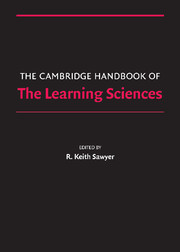Book contents
- Frontmatter
- Contents
- Preface
- Contributors
- 1 Introduction
- PART I FOUNDATIONS
- PART II METHODOLOGIES
- PART III THE NATURE OF KNOWLEDGE
- PART IV MAKING KNOWLEDGE VISIBLE
- PART V LEARNING TOGETHER
- PART VI LEARNING ENVIRONMENTS
- 28 Motivation and Cognitive Engagement in Learning Environments
- 29 Learning as a Cultural Process
- 30 Prospects for Transforming Schools with Technology- Supported Assessment
- 31 Internet Use in Schools
- 32 Teacher Learning Research and the Learning Sciences
- 33 Scaling Up
- 34 Conclusion
- Afterword: After How Comes What
- Epilogue: The Fundamental Issue in the Learning Sciences
- Author Index
- Subject Index
- References
31 - Internet Use in Schools
Promise and Problems
Published online by Cambridge University Press: 05 June 2012
- Frontmatter
- Contents
- Preface
- Contributors
- 1 Introduction
- PART I FOUNDATIONS
- PART II METHODOLOGIES
- PART III THE NATURE OF KNOWLEDGE
- PART IV MAKING KNOWLEDGE VISIBLE
- PART V LEARNING TOGETHER
- PART VI LEARNING ENVIRONMENTS
- 28 Motivation and Cognitive Engagement in Learning Environments
- 29 Learning as a Cultural Process
- 30 Prospects for Transforming Schools with Technology- Supported Assessment
- 31 Internet Use in Schools
- 32 Teacher Learning Research and the Learning Sciences
- 33 Scaling Up
- 34 Conclusion
- Afterword: After How Comes What
- Epilogue: The Fundamental Issue in the Learning Sciences
- Author Index
- Subject Index
- References
Summary
Schools in the United States are often characterized as bastions of stability, as institutions still strongly shaped by the early twentieth century, whose mission, rather ironically, is to prepare students to function effectively in the twenty-first century (Molenda, 1992). Yet, schools have changed quite dramatically in at least one way during the last twenty-five years. Specifically, in the 1980s school districts in the United States, as well as in many other developed countries, began to purchase large numbers of computers for instructional use, and in the mid-1990s they built on this trend by very rapidly connecting classrooms to the Internet. Furthermore, many school districts adopted computer technology with the specific goal of changing students' educational experiences in ways that would improve their education.
This chapter explores the introduction of the Internet into schools for instructional purposes, examining the Internet's potential to improve education and the factors that appear to impede full realization of this potential. This chapter focuses on Internet use, rather than on the use of computer technology more generally, because different kinds of computer use have somewhat different kinds of potential to change education (Levin & Bruce, 2003; Means, 1994; Salomon, 1993) and they do not face exactly the same set of impediments to the realization of their potential. For example, cognitive tutors are designed specifically to help students learn particular cognitive skills.
- Type
- Chapter
- Information
- The Cambridge Handbook of the Learning Sciences , pp. 521 - 534Publisher: Cambridge University PressPrint publication year: 2005
References
- 3
- Cited by



